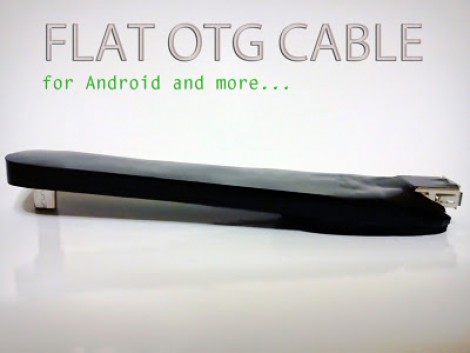
[Cosimo Orlando] has a Motorola Xoom tablet. It’s an Android device that works great as a tablet, but can double as a Laptop when you need it to by adding a keyboard. The problem he was having is that the USB On-The-Go cables that he tried were never the right size or orientation. So he scavenged them for parts and built his own flat cable for a custom fit.
The final product pictured here actually uses protoboard to give the body some strength. [Cosimo] first laid out the dimensions on the substrate using a felt-tipped pen. He then took connectors from his mis-sized commercial cables and affixed them to the board with a combination of hot glue and solder. From there, just connect the five data lines and ground with some jumper wire and test for continuity. He finished this off with what he calls ‘adhesive plastic glossy black’ shaped to make a decent looking case. If you have any idea what product was used here, let us know by leaving a comment.















It looks like what we know in the UK as ‘sticky-back plastic’ or Fablon – essentially adhesive backed vinyl or PVC sheet.
a guess
http://www.alibaba.com/showroom/glossy-black-self-adhesive-pvc-film.html
i think he just forgot a comma
adhesive plastic, glossy black
actually.. electrical tape fits that bill too, ha ha *face-palm*
I think the plastic is self adhesive PVC film.
at first i thought he may be using http://www.plastidip.com/
“five data lines and ground” am i missing somthing? O.o i thought USB A had 2 data and 2 power + shield
https://secure.wikimedia.org/wikipedia/en/wiki/USB_On-The-Go#OTG_Micro_Plugs
:)
I believe Tempmj is right, it is plastidip but there are many products that would work, latex, polyurethane, acrylic, and more.
The easiest DIY alternative is black ABS dissolved in acetone. Just make sure it doesn’t dissolve anything you don’t want.
If you make it suitably thin and dip your stuff in it, it leaves a nice smooth and glossy finish.
Uhhhhhhhh…… Sooooo….. Is this cable for charging only, or for data too? If it’s used for USB2.0 data rates, then this is beyond stupid. Differential impedance of these crappy wires laid across this board will NOT be near 90 ohms and will vary greatly across the board – I can’t even imagine what this looks like on a TDR. For charging, meh, this works…. For data? NO.
Also, @biozz, look at your mini USB connector, you’ll see 5 pins… Not 4. It has a 5th ‘ID’ pin.
He is using it for a keyboard, so no high speeds involved.
I really like the idea, I’d make it into a stand for the tablet..
I Believe the 5th pin is connected to ground, which then puts the device into host mode, to allow peripherals to be connected.
“OTG adds a fifth pin to the standard USB connector, called the ID-pin; the micro-A plug has the ID pin grounded, while the ID in the micro-B plug is floating. The device that has a micro-A plugged in becomes an OTG A-device, and the one that has micro-B plugged becomes a B-device. The type of the plug inserted is detected by the state of the pin ID.” (from wikipedia)
Interesting build. Maybe it’s just me, but when I read cable something flexible comes to mind.
Can’t claim to know what he used, but a similar finish can be had with an Alumilite resin. Such as:
http://www.alumilite.com/ProdDetail.cfm?Category=Casting%20Resins&Name=Alumilite%20Regular
It’s a thin, 2 part liquid that can be poured into a form, and hardens to a nice gloss finish like that (if the form is smooth). It’s at most hobby shops (around Calgary at least), and pretty handy to make little parts with. The small bottles go farther than you would think.
You could do it the easy way with heatshrink. You can get nice thick stuff with heat-activated adhesive lining.
Looks like sugru or oogoo:
http://sugru.com/
http://www.instructables.com/id/How-To-Make-Your-Own-Sugru-Substitute/